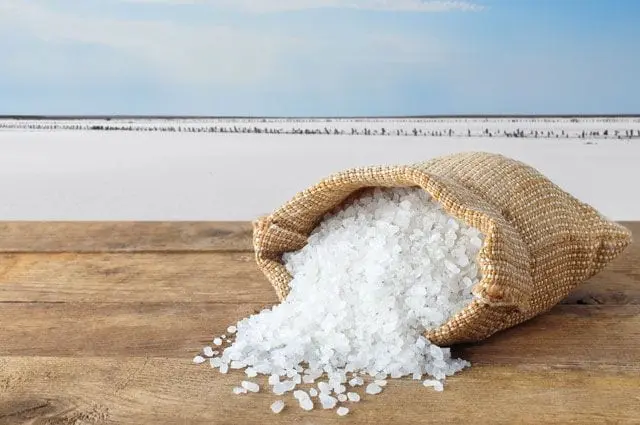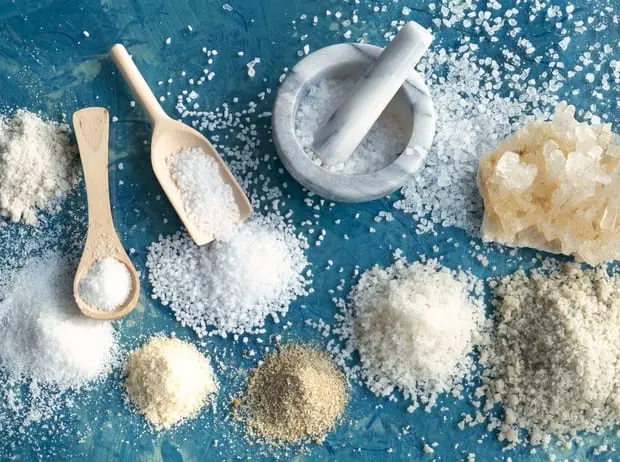Description
Salt is the most valuable product of the sea created by nature, which has been preserved in the bowels of the earth in its original form, having been there for millions of years, without being exposed to the products of human activity and other technogenic influences.
The most accessible and richest sources of trace elements are sea salt and its deposits in the form of rock salt. The deposits were formed in the form of a halite mineral containing an inorganic substance NaCl (sodium chloride) and inclusions of naturally occurring trace elements, which are visually identified as particles with shades of “gray”.
NaCl is a vital substance found in human blood. In medicine, 0.9% sodium chloride aqueous solution is used as a “saline solution”.

Sodium chloride, more familiar to us as salt, is essential for the proper functioning of the human body. Table salt is a fundamental building block of our body, just like water.
It is involved in many biochemical processes in the body. Salt is not produced by our body and comes from outside. Our body contains about 150-300 grams of salt, some of which is excreted daily along with the excretion processes.
To replenish the salt balance, the loss of salt must be replenished, the daily rate is 4-10 grams, depending on individual characteristics. For example, with increased sweating (when playing sports, in the heat), the amount of salt intake should be increased, as well as with certain diseases (diarrhea, fever, etc.).
Salt formula

The benefits of salt

Lack of salt in the body has detrimental consequences: cell renewal stops and their growth is limited, which can subsequently lead to cell death. Salty taste stimulates salivation, which is especially important for food digestion.
In addition to saliva, sodium and chlorine are also present in pancreatic juice, bile and are involved in digestion at different levels. Sodium promotes the absorption of carbohydrates, and chlorine, in the form of hydrochloric acid, accelerates the digestion of proteins.
In addition, sodium chloride supports energy metabolism within cells. Salt regulates the circulation of fluids in the body, is responsible for thinning the blood and lymph, as well as removing carbon dioxide. Salt is of great importance in regulating blood pressure, the rise of which is often blamed on salt.
Despite the important function of sodium chloride for our body, it also has disadvantages. Salt is of great importance in regulating blood pressure, the rise of which is often blamed on salt. Excess salt is deposited in the joints, in the kidneys. The increased salt content in the blood contributes to the development of atherosclerosis.
Salt mining

The industry produces table salt, fine, crystalline, boiled, ground, lumpy, crushed, and grain. The higher the salt grade, the more sodium chloride it contains and the less water-insoluble substances. Naturally, high-grade edible salt tastes saltier than low-grade salt.
But salt of any kind should not contain foreign impurities visible to the eye, and the taste should be purely salty, without bitterness and sourness. Sea salt is one of the healthiest types of salt that is rich in minerals. If you care about your health, then it is worth eating this particular species. Natural unrefined salt – rich in iodine, sulfur, iron, potassium and other trace elements.
There is also such a type of salt as dietary. It has a reduced sodium content, but added magnesium and potassium, which are important for the full functioning of the heart and blood vessels. Extra salt is an “aggressive” type of salt, because it does not contain anything other than pure sodium chloride. All additional trace elements are destroyed as a result of the evaporation of water from it during cleaning with soda.
Iodized salt

Iodized salt deserves a separate discussion. There are no territories in Russia where the population would not be exposed to the risk of developing iodine deficiency diseases. The Chelyabinsk region is an endemic area (an area with a low iodine content in soil, water, local food).
For ten years, there has been an increase in the incidence of iodine deficiency. Today, the most reliable and simple way to effectively prevent iodine deficiency is iodization of table salt. The huge advantage of this method is that almost all people consume salt throughout the year. Moreover, salt is a cheap product available to all segments of the population.
Getting iodized salt is simple: add potassium iodide to ordinary food salt in a strict ratio. With storage, the iodine content in iodized salt gradually decreases. The shelf life of this salt is six months. After that, it turns into regular table salt. Store iodized salt in a dry place and in a tightly closed container.
History

The flames of the fire illuminated the entrance to the cave, the rocks and branches of trees hanging over it. People were sitting around the fire. Their bodies were covered with animal skins. Bows, flint-tipped arrows and stone axes lay near the men. The children collected branches and threw them into the fire. The women roasted freshly skinned game over the fire, and the men, tired of hunting, ate this half-baked meat, sprinkled with ashes, with coals sticking to it.
People did not know salt yet, and they liked the ash, which gave the meat a pleasant, salty taste.
People then did not yet know how to make fire: it came to them by accident from a tree lit by lightning or from the red-hot lava of a volcano. Gradually, they learned how to store embers, fan sparks, learned to fry meat by sticking it on a stick and holding it over the fire. It turned out that meat does not spoil so quickly if it is dried over a fire, and it lasts a long time if it hangs in the smoke for a while.
The discovery of salt and the beginning of its use was an era of the same significance as the acquaintance of man with agriculture. Almost simultaneously with the extraction of salt, people learned to collect grain, sow plots of land and harvest the first crop …
Excavations have shown that ancient salt mines existed in the Slavic cities of the Galician land and in Armenia. Here, in the old adits, not only stone hammers, axes and other tools have survived to this day, but also the wooden supports of the mines and even leather sacks, in which salt was transported 4-5 thousand years ago. All this was saturated with salt and therefore could survive to this day.

When conquering a city, country, people, the Romans forbade soldiers, on pain of death, to sell salt, weapons, a whetstone and grain to the defeated enemy.
There was so little salt in Europe that salt workers were highly respected by the population and were called “noble-born”, and salt production was considered a “holy” deed
“Salt” allegorically called the payment of Roman soldiers, and from this came the name of the small coin: in Italy “soldi”, in France “solid” and the French word “saler” – “salary”
In 1318, King Philip V introduced a salt tax in the twelve largest cities in France. From that time on, it was allowed to buy salt only in state warehouses at an increased price. Coastal residents were prohibited from using sea water under the threat of a fine. Residents of saline areas were forbidden to collect salt and saline plants.









